Photographs: Courtesy: Wikimedia Surajeet Das Gupta & Sharmistha Mukherjee
Competition and capacity issues have led to a drop in market share for Maruti's premium hatchback. A new version aims to re-capture it.
A few years ago, the country's largest car maker Maruti Suzuki had two choices.
It could continue flogging its old war horse, the Swift, which was launched in 2005, for a few more years and sell similar volumes, even though it was aware that the product cycle of cars are increasingly shrinking.
Or it could make a conscious decision to be ahead of its product cycle curve and replace it by a completely revamped car much before consumers got bored with the old one and stopped buying it entirely.
Click on NEXT for more...
Swift plans to continue as king of hatchbacks
Image: Third generation Suzuki Swift ( 2010-present).Photographs: Courtesy: Wikimedia Commons
The new model would in fact be a completely new car. It would have a new, larger platform, swanky interiors and better fuel efficiency.
"We chose to make the change two years earlier, rather than wait till when its sales start to decline," says the soft spoken Mayank Pareek, managing executive officer sales and marketing.
"Our reading is that consumers look at changing their cars every six years and by doing it earlier we also save on marketing costs."
The re-engineering of the Swift - an iconic car that pretty much created the premium hatchback category that it sits in - is more than just an exercise in refurbishment.
Click on NEXT for more...
Swift plans to continue as king of hatchbacks
Image: Suzuki Swift S-Concept.Photographs: Courtesy: Wikimedia Commons
The hatchback category has become a fast growing one.
Sales grew by 20 per cent in the first quarter of this financial year compared to an industry growth of just under 9 per cent, offering considerable upside for companies who are able to put out vehicles in this category that are easy on the wallet but don't compromise on style or high-end features.
For Swift, which sold over 140,000 units giving it a 32 per cent market share last year and making the car the 4th-largest selling car in the industry after the Alto, Hyundai i10 and Wagon R - this is a market that the company needs to dominate if it wants to continue posting strong numbers.
Click on NEXT for more...
Swift plans to continue as king of hatchbacks
Image: Ford Figo.And yet, dominating in the past two years has been difficult for the king of the hatchback hill due to swift incursions by canny rivals.
Ford, which launched the Figo last year, decided to play the price warrior by offering their car at an aggressive Rs 369,0000 - the cheapest in the category and at least Rs 40,000 cheaper than the Swift. The ploy worked.
The model has already gobbled up 15 per cent market share in this segment.
The Volkswagen's Polo, launched in February last year, has also created a niche for itself in the market selling 3,000 units every month and snatching a 7 per cent share.
Click on NEXT for more...
Swift plans to continue as king of hatchbacks
Image: Honda Brio.In fact, the entire category has become a hot one for car makers and this can only put further pressure on the Swift.
In 2009, for instance, there were only 8 models in this range.
Currently, there are 14, and at least two more models which include the Honda Brio and a new product from Renault will be added to this list this financial year.
All of this has caused the Swift to drop from 32 per cent to 24 per cent market share - something that it could not have dreamed of during its heyday.
Swift's market share slump is not just a result of competition, but also because of hits taken due to a strike as well as restrictions in capacity.
But with the new Swift, the Japanese car maker is now looking to get back its lost ground.
Click on NEXT for more...
Swift plans to continue as king of hatchbacks
Image: Suzuki Swift Plug-in Hybrid in Tokyo Motor Show 2009.Photographs: Courtesy: Wikimedia Commons
It will be producing (and, it hopes, selling) 16,000 to 17,000 Swifts a month compared to earlier monthly sales of 11,0000 to 12,000.
Based on these numbers, Maruti will see its overall market share in this segment (together with the Ritz) go up from 48 per cent to 53 per cent.
Production of higher number of cars will be possible because Maruti will have its fourth plant up and running by September, helping hike its capacity from 1.2 million to 1.45 million by the end of this financial year.
So far, Pareek's gamble to go in for the new Swift ahead of schedule seems to be working nicely for the company if pre- booking numbers are anything to go by.
Click on NEXT for more...
Swift plans to continue as king of hatchbacks
Image: Interior view of Suzuki Swift.Maruti has already grabbed over 38,000 eager beavers for the car even before its commercial launch on August 17 - that too, despite the fact that the company has not divulged its price tag to customers except to say that it will be significantly higher than the older model which was available at a starting price of Rs 409,000.
Out of that total, 22,000 of them happen to be consumers who had earlier booked the older Swift but were given the option to shift to the new one after the company decided to stop its production.
Pareek admits that it will take them more than three months to clear the current order backlog since the numbers are beginning to pile up.
And, he says that 85 per cent of the bookings are for the diesel model.
Click on NEXT for more...
Swift plans to continue as king of hatchbacks
Image: Maruti Swift 2011.With so many attractive hatchbacks tooling around urban India, it is perhaps easy to forget how revolutionary the Swift was when it was first launched in 2005, just 6 years ago, but eons in automotive years.
With the Swift, Maruti had decided to cater to the needs of a more demanding customer - different from the profile of the family-oriented small car buyer - who was 30-32 years of age and just married or was about to be.
These potential customers - whose salaries were around Rs 25,000 per month - were looking for a hatchback which also had high-end car features, better interiors and a distinctive look for which they were ready to pay a premium.
Click on NEXT for more...
Swift plans to continue as king of hatchbacks
Image: Rear view of the New Swift.Pareek says that the same segment is being targeted for the new Swift - but this time the age profile is a much younger 28 to 31 years with a salary of Rs 35,000 a month (adjusted to inflation).
To cater to a younger market, the new Swift will be much bigger in size, will have a fuel efficiency which is 5-6 per cent higher than the older model and of course will have much more elaborate interiors a key demand during customer focus groups.
So where does Maruti expect the buyers to come from?
One group comprises existing buyers of the Swift.
The company already has a base of 600,000 Swift consumers who they could woo to upgrade their car to this new model.
Click on NEXT for more...
Swift plans to continue as king of hatchbacks
Image: Concept version of Suzuki Swift.Says Pareek: "30 per cent of the sales of Swift come from consumers who already have a Swift. We expect the same to happen as brand royalty is very high."
More importantly, it is also expecting more and more of the 33,000 customers who had booked the older Swift to upgrade to the new car.
The company has another valuable resource which it can use to scare up more Swift customers - a mammoth database comprising of its existing 6.5 million customers.
"Our data base shows that 58 per cent of the customers change their vehicles every six years. We will tap them for the Swift," adds Pareek.
But it's not just Maruti, or specifically Swift loyalists, who are queuing up for these cars. Pareek says that he is also getting customers who are first time buyers of the Maruti brand.
Click on NEXT for more...
Swift plans to continue as king of hatchbacks
The company is also cashing on the fact that the resale value of the car is at least 25 per cent higher than its competitors (for a four year car) which is important for a buyer.
Maruti is going big with digital marketing blogs, social media sites and its own web pages.
It had great success doing so with their previous model in 2005, at a time when the net was not being fully utilized for these kinds of things, although 76 per cent of the customers had researched the car online before making a final decision in the first six months of the launch.
Click on NEXT for more...
Swift plans to continue as king of hatchbacks
Image: Maruti Swift.Pareek also points out that the company is not looking at a different strategy to sell the car in rural markets.
"The rural markets are displaying the same kind of characteristics as buyers in urban areas.
One dealer near Kota in Rajasthan sold 21 Swifts in a day and said that there is no difference in the aspiration," says Pareek.
Sometimes it takes tough environments and stiff challenges to emerge fitter and faster than ever before and Maruti will hope that this is exactly what is going to happen to its new weapon on wheels.
If Swift manages to wrest market share from its fiercely competitive rivals, it can easily become the second largest selling model in the country and propel its parent company to a position that is miles ahead of its closest competitor.


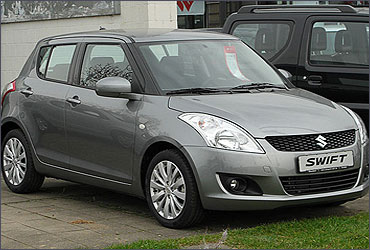
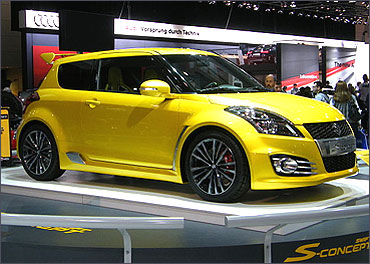
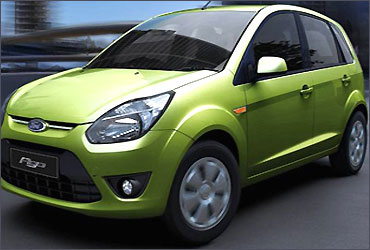

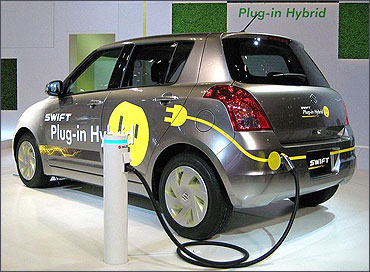

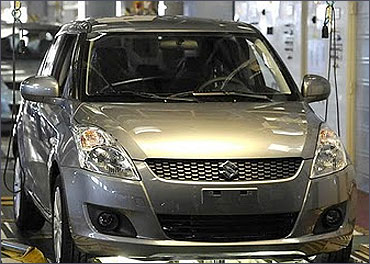
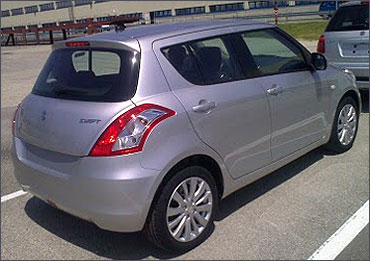
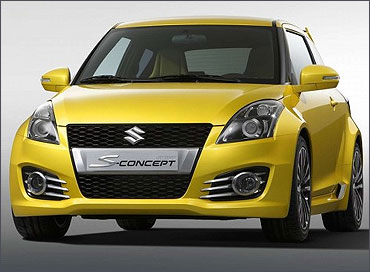
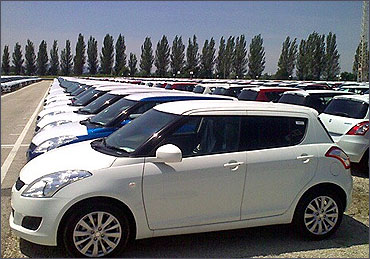
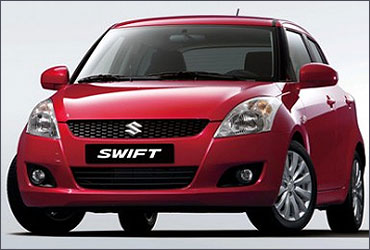

article